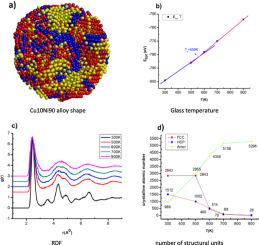Materials Today Communications ( IF 3.7 ) Pub Date : 2021-09-20 , DOI: 10.1016/j.mtcomm.2021.102812 Dung Nguyen Trong 1, 2 , Van Cao Long 1

|
This paper studies the influence factors of the Earth's surface such as: Impurity concentration of Ni in Cu, alloy, x = 0.1 (10%), 0.3 (30%), 0.5 (50%), 0.7 (70%), 0.9 (90%); Temperature (T), T = 300 K, 500 K, 600 K, 700 K, 900 K at pressure (P), P = 0 GPa; pressure P = 50 GPa, 100 GPa, 150 GPa, 200 GPa, 250 GPa, 300 GPa, 350 GPa, 400 GPa at T = (300 K, 550 K, 900 K); annealing time (t), t = 200 ps at the depth of the Earth’s surface (h), h = 273 km (300 K, 14.05 GPa), 546 km (550 K, 28.104 GPa), 820 km (900 K, 42.16 GPa) on the heterogeneous dynamics of Cu1−xNix alloy by Molecular Dynamics (MD) simulation method with Sutton-Chen (SC) potential embedded and free boundary conditions. The results show, that for Cu1−xNix alloy, there always exist links Cu-Cu, Cu-Ni, Ni-Ni, and 04 types of structural units: FCC (Face-Centered Cubic), HCP (Hexagonal Close-Packed), BCC (Body-Centered Cubic), Amor (Amorphous). When the impurities concentration of Ni in Cu1−xNix alloy increases, structural units’ number of FCC, HCP, BCC, Amor change, and the largest crystallization process appears at the impurity concentration of Ni with x = 90%. When the temperature is increased, the structure of Cu1−xNix alloy changes from the crystallization state to a liquid state, the crystallization temperature (Tg) identified as Tg = 550 K. When increase pressure (P), the annealing time (t), then crystallization process occurs at T = 550 K faster than at T = 300 K and doesn’t occur at T = 900 K. Whereas increasing h leads to increasing Etot, structural units’ number of FCC, HCP and Amor decreases, which lead to the decreasing crystallize process of the Cu10Ni90 alloys. The results obtained could be used as the basis for experimental research in the future.
中文翻译:

影响地球表面深度的因素对Cu1-x Nix合金的异质动力学, x = 0.1, 0.3, 0.5, 0.7, 0.9 通过分子动力学模拟方法
本文研究了地球表面的影响因素如:Cu 、合金中Ni的杂质浓度,x=0.1(10%)、0.3(30%)、0.5(50%)、0.7(70%)、0.9( 90%); 温度 (T),T = 300 K、500 K、600 K、700 K、900 K 压力 (P),P = 0 GPa;压力 P = 50 GPa, 100 GPa, 150 GPa, 200 GPa, 250 GPa, 300 GPa, 350 GPa, 400 GPa at T = (300 K, 550 K, 900 K); 退火时间 (t), t = 200 ps 在地球表面深度 (h), h = 273 km (300 K, 14.05 GPa), 546 km (550 K, 28.104 GPa), 820 km (900 K, 42.16 GPa)通过分子动力学 (MD) 模拟方法在 Cu 1-x Ni x合金的异质动力学上使用 Sutton-Chen (SC) 势嵌入和自由边界条件。结果表明,对于 Cu 1−x Ni x合金,总是存在联系的Cu-Cu、Cu-Ni、Ni-Ni,以及04种结构单元:FCC(面心立方)、HCP(六角密堆积)、BCC(体心立方)、Amor (无定形)。当Cu 1-x Ni x合金中Ni的杂质浓度增加时,FCC、HCP、BCC、Amor的结构单元数发生变化,最大的结晶过程出现在Ni的杂质浓度x=90%处。当温度升高时,Cu 1-x Ni x合金的结构由结晶态转变为液态,结晶温度(T g)记为 T g= 550 K。当增加压力 (P)、退火时间 (t) 时,结晶过程在 T = 550 K 时比在 T = 300 K 时发生得更快,并且在 T = 900 K 时不会发生。而增加 h 导致随着E tot的增加,FCC、HCP和Amor的结构单元数量减少,导致Cu 10 Ni 90合金的结晶过程减少。所得结果可作为今后实验研究的基础。











































 京公网安备 11010802027423号
京公网安备 11010802027423号